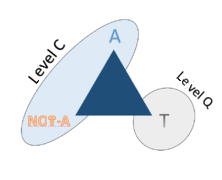
Ontological thinking, the third included and the Other
Since ancient times, ontological thinking has admitted two levels of reality (it could be truth, but aletheia since the Greek classics is something else), Parmenides summarized it in being is and non-being is not, Heraclitus went further by discovering that everything flows, we can’t pass by the same river twice because the waters flow over us, but it is the river is, although it changes.
(it could be truth, but aletheia since the Greek classics is something else), Parmenides summarized it in being is and non-being is not, Heraclitus went further by discovering that everything flows, we can’t pass by the same river twice because the waters flow over us, but it is the river is, although it changes.
This thought evolved into mechanical physics, action and reaction, inertia and movement, attribute and force, in short everything that seems very “natural” today, but quantum mechanics has already gone beyond this and it was Stéphane Lupasco who theorized the third included, already proven by current quantum physics.
This third element reveals a logical paradox that the physicist Barsarab Nicolescu developed as a third level of reality (picture), and went so far as to call for a reform of Education and Thought, stating: “one thing is certain: a large gap between the mentality of the actors and the internal development needs of a type of society invariably accompanies the fall of a civilization” (Nicolescu, 2002), in other times the models were: aristotelian mechanics (immovable motor) and the god of platonic thought (High Good) which are still influencing society today.
As we’ve already mentioned a few times, the thought of Augustine of Hippo, who overcame Manichaeism, his belief prior to Christianity, overcame this dualistic reality and what idealism put into “action” was nothing but an idea, it lacked movement outside of this logic.
The Copernican revolution pointed to the movement of the stars and heliocentrism.
The Copernican revolution pointed to the movement of stars and heliocentrism, today we have a black hole as the center of our galaxy, and we are increasingly penetrating this mystery and that of subatomic particles and facing the tunneling effect (an intermediate state between quantum particles) and wormholes (paths in the universe beyond the space-time dimensions).
Modern thought included the question of the Other, no longer as a not-I, it is a new hermeneutics beyond the affirmation of subject and object (idealist), Paul Ricoeur wrote “The self as other”, Habermas “The inclusion of the other” as a theory of re-knowledge, Byung-Chul Han wrote “The Exclusion of the Other” as the media perspective of our times, Emmanuel Lévinas’ book “Humanism of the Other Man” represents a radical alterity that challenges Western thought and its philosophy of identity, very topical when we think about nationalism.
Martin Buber (I-Thou) goes further and sees in the Other an ontological relationship, it’s not just a question of ethics, it’s the vision of a being-for-the-other in the world, it goes beyond being with the other being, Levinas’ “il y a”, a fundamental step in relationships is to then discover an included third party and think that trinitarian relationships are possible, rare as in the quantum universe, but they do exist.
Nicolescu, Basarab (2002). Manifesto of Transdisciplinarity. SUNY Press.









